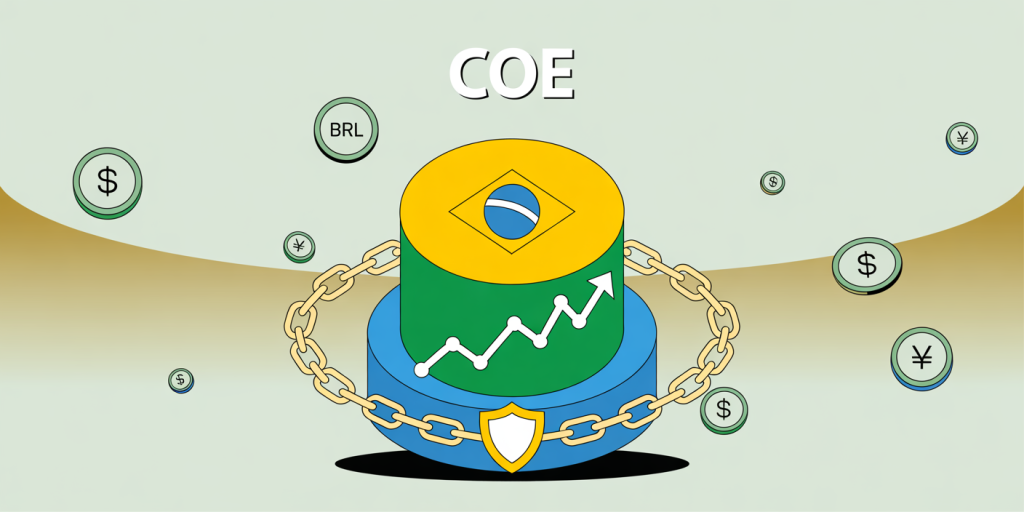How Structured Notes (COEs) Work in Brazil
Structured Notes, locally known as Certificados de Operações Estruturadas (COEs), have gained increasing prominence in Brazil’s financial market over recent years. These hybrid financial instruments combine elements of fixed income and derivatives, offering investors tailored risk-return profiles with opportunities for capital protection and enhanced yields. This article explores how COEs function within the Brazilian context, examining their structure, regulatory environment, risk factors, and their role among other investment options, alongside relevant data, practical examples, and future outlooks.

—
Understanding Structured Notes: The Brazilian Context
Structured Notes or COEs in Brazil are designed to address the demand for diversified income opportunities in an environment marked by historically low interest rates and economic fluctuations. According to the Brazilian Securities and Exchange Commission (CVM), COEs started gaining traction after regulatory support increased in the early 2010s as a means to democratize access to derivative-based investments, previously available only to institutional investors.

A COE typically bundles a fixed income security with a derivative contract such as options or swaps to generate predefined payout structures. This combination allows investors to participate in upside potential tied to underlying assets like stocks, currencies, or commodities while potentially preserving principal in adverse market conditions. For many retail investors in Brazil, COEs serve as a middle ground between traditional fixed-income products and higher-risk variable income options.
The Brazilian market offers a broad variety of COEs with maturities ranging from one month to several years, catering to different risk appetites. As of 2023, data from the Brazilian Association of Capital Markets (B3) reveals that COE issuance volumes exceeded R$ 30 billion, underscoring their growing importance as a financial instrument.
—
Structure and Mechanics of COEs in Brazil
At the core, a COE in Brazil consists of two primary components: a fixed income product, usually a government bond or a bank deposit, and a derivative instrument like options contracts. The fixed income element ensures partial or full capital protection at maturity, while the derivative determines the potential gain tied to the performance of underlying assets.
For instance, consider a COE linked to the Ibovespa index. The capital investment is split, with a portion used to purchase zero-coupon government bonds maturing at par value and the remaining portion used to buy options related to Ibovespa’s future value. If the index appreciates past a predetermined threshold by maturity, the investor gains a positive return tied to that performance. Conversely, if the index falls, the investor’s principal may still be protected depending on the COE’s design.
A practical example occurred in 2021 with a COE linking to the USD/BRL exchange rate. Investors received capital protection at 100% and a return linked to the depreciation of the Brazilian real against the US dollar. Given the inflationary environment and fluctuating currency trends, this COE provided a way to hedge local currency risk while guaranteeing the principal.
The terms of COEs are clearly outlined in offering documentation, detailing maturity date, capital protection level (which can vary between 80% to 100%), maximum returns, and the underlying index or asset. This transparency enables investors to analyze risk-return combinations and choose structures aligned with personal investment objectives.

—
Regulatory Framework Governing COEs in Brazil
COEs are regulated by the Comissão de Valores Mobiliários (CVM), Brazil’s securities and exchange commission, which ensures investor protection and market transparency. The CVM issued Instruction 476 in 2009, which set guidelines for public offerings of securities, including COEs, under simplified registration processes.
To protect retail investors, the CVM mandates that institutions distribute COEs only after providing clear disclosure of risks, potential returns, fees, and contractual terms. This obligation aims to prevent mis-selling and ensure that products offered suit clients’ risk profiles. In addition, banks and financial agents must register COEs on the B3 exchange, reinforcing transparency and market surveillance.
Another important aspect is taxation. COEs enjoy favorable tax treatment under Brazilian law: earnings from COEs are subject to the same taxation as fixed income instruments, with income tax rates depending on the investor’s holding period (typically 22.5% for holding periods under 180 days and gradually decreasing for longer durations). There is no levy of IOF tax (Tax on Financial Operations) if the COE is held until maturity, enhancing their tax efficiency compared to direct derivatives trading.
The regulatory supervision and standardized practices have contributed to a surge in COE popularity. According to B3’s 2022 report, COEs accounted for nearly 8% of the total retail investment volume in high-return products, reflecting growing investor confidence.
—
Risks and Advantages of Investing in COEs
Like all financial instruments, COEs present both advantages and risks that investors must consider carefully. One of the primary benefits of COEs is capital protection. In many structures, part or all of the invested capital is safeguarded so that, even in unfavorable scenarios for the underlying asset, investors are not exposed to principal loss. This is particularly attractive in volatile markets or for conservative investors seeking equity-like returns while minimizing downside risk.
Additionally, COEs offer customization. Investors can access exposure to diverse underlying assets (e.g., foreign currencies, commodities, stock indices) without directly entering these markets, circumventing complexities associated with derivatives trading. COEs also provide diversification benefits within fixed income-heavy portfolios.
On the risk side, COEs sometimes involve limited liquidity since they are often held until maturity. Secondary market trading of COEs exists but may be thin or involve costs, making early exit less attractive. Furthermore, returns are capped in many COEs, so investors do not benefit fully if the underlying asset significantly outperforms the strike price or contract terms.
Another noteworthy risk is issuer credit risk. Since COEs are debt obligations issued by financial institutions, the investor is exposed to the creditworthiness of the issuer. If the bank or institution faces insolvency, capital protection could be jeopardized, though large Brazilian banks tend to have solid credit ratings.
| Advantage | Risk |
|---|---|
| Capital protection (partial/total) | Liquidity constraints |
| Access to diverse asset classes | Capped upside potential |
| Tax efficiency | Issuer credit risk |
| Transparent contractual terms | Complexity of product understanding |
—
Comparing COEs with Traditional Investment Options
COEs are best understood when compared to other popular investment instruments in Brazil such as fixed income bonds, mutual funds, and direct stock investments.
Fixed income instruments, including government bonds (Tesouro Direto) and bank certificates of deposit (CDBs), emphasize principal safety and steady returns but offer limited upside potential beyond interest payments. Meanwhile, stocks provide higher potential returns but involve considerable volatility and risk of principal loss.
Mutual funds offer diversification and professional management but entail fees and sometimes limited transparency regarding specific holdings. COEs blend these elements: providing fixed income safety with potential enhanced returns derived from derivatives linked to various assets.
For example, a Brazilian investor seeking exposure to the commodities sector might invest through a commodity-linked COE, gaining participation in price appreciation without direct commodity trading or futures market exposure. Additionally, COEs’ capital protection feature makes them suitable as an adjunct to portfolios where risk mitigation is paramount.
| Investment Type | Risk Profile | Potential Return | Liquidity | Tax Considerations |
|---|---|---|---|---|
| COEs | Moderate | Moderate to High | Low to Moderate | Tax-efficient |
| Fixed Income Bonds | Low | Low to Moderate | High | Tax-efficient |
| Stocks | High | High | High | Capital gains tax |
| Mutual Funds | Variable | Variable | High | Dependent on type |
—
Practical Applications and Real Cases in Brazil
Practical cases often highlight how COEs serve the needs of Brazilian retail investors facing economic uncertainties. During the COVID-19 pandemic crisis in 2020, several COEs linked to the performance of the Ibovespa and currency exchange rates offered opportunities to hedge volatility while ensuring principal security.
One notable issuance by a prominent Brazilian bank was a COE in 2021 linked to the silver price, with 90% capital protection and a capped return of 15%. Given Brazil’s role as a commodity exporter and the global economic recovery driving precious metals prices, this COE attracted significant participation from individual investors seeking portfolio diversification.
Similarly, in 2023, amid rising inflationary pressures, COEs linked to the IPCA (Brazil’s Consumer Price Index) provided inflation-adjusted returns plus a bonus yield, helping investors safeguard real purchasing power. According to the CVM, approximately 42% of COE issuances in 2023 were inflation or currency-linked, reflecting investor priorities.
Moreover, financial advisors often design tailored COE portfolios combining short-term capital protection with longer-term growth exposure through variable asset-linked components. This customization has made COEs a staple in diversified asset allocation strategies, especially for conservative yet growth-seeking investors.
—
Future Perspectives for COEs in Brazil
Looking forward, the landscape for COEs in Brazil appears promising amid ongoing economic transformation and regulatory evolution. The current macroeconomic environment—with interest rates gradually normalizing after record lows in recent years—might somewhat moderate the aggressive yield demand that boosted COE issuance previously. Still, as investors become more sophisticated and seek alternatives beyond traditional fixed income, COEs’ appeal persists.
Technological advancements and digital platforms are enhancing COE accessibility by simplifying subscription procedures and offering real-time pricing information. This digital shift is expected to expand the investor base, particularly among younger retail clients familiar with fintech innovations.
Regulatory bodies continue refining disclosures and risk management standards, aiming at balancing product innovation with investor protection. Emerging trends include COEs linked to ESG (Environmental, Social, and Governance) indices, catering to socially responsible investing preferences.
Furthermore, the internationalization of Brazilian financial markets may open opportunities for COEs denominated in foreign currencies or linked to global indices, enabling Brazilian investors to diversify globally while enjoying the capital protection features inherent to these structures.
The table below summarizes some anticipated trends and their potential impact:
| Trend | Impact on COEs |
|---|---|
| Interest rate normalization | Potential reduction in fixed income returns, increased product innovation |
| Digital distribution platforms | Greater accessibility, higher volume |
| ESG-linked COEs | Attraction of socially conscious investors |
| Enhanced regulatory oversight | Improved transparency and investor trust |
| Global asset linkages | Broadening diversification options |
In conclusion, while the COE market in Brazil continues to evolve, its foundational value proposition — combining capital protection with strategic exposure to diverse assets — positions these instruments as indispensable tools for achieving tailored investment goals. Investors and financial professionals alike should stay abreast of COE developments to optimally harness their benefits in a dynamic financial environment.
